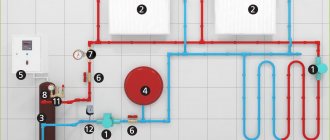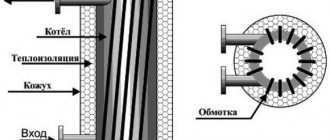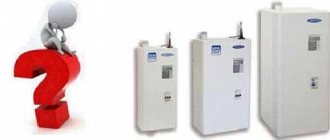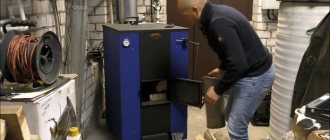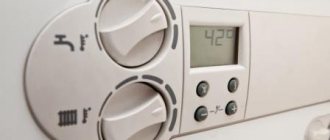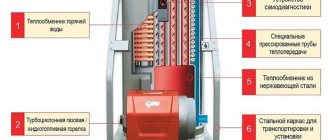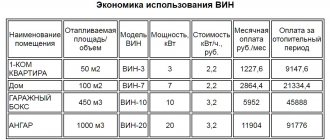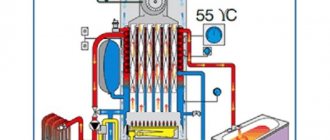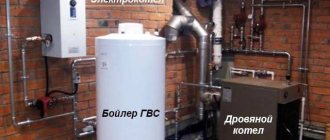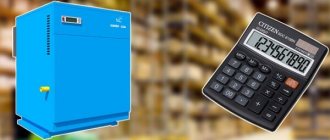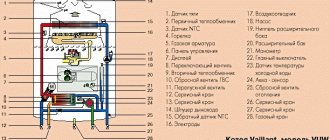Home / Electric boilers
Back
Published: 06/02/2019
Reading time: 7 min
0
3319
A double-circuit electric boiler is a popular type of heating equipment and has many advantages. It is customary to install it in rooms remote from centralized gas and water supplies in order to heat the building and supply hot water. Before purchasing a unit, you must carefully study the principle of its operation and performance characteristics.
- 1 Types of double-circuit boilers
- 2 Design and principle of operation of the electric boiler 2.1 Connection diagram
- 3.1 How to calculate power
What are double-circuit electric boilers?
Double-circuit electric boilers are almost always wall-mounted models, which, with the same technical characteristics and the same or slightly larger dimensions, combine the functionality of two devices at once - the heating boiler itself and a flow-through (less often storage) water heater. The coolant from the heating circuit is never mixed with sanitary water in the hot water supply (DHW) circuit.
Double-circuit electric models are best used in small residential buildings with an area of up to 150-200 m2. And it’s not just about high operating costs, but about the length of the pipeline from the boiler to the points of consumption, which should not exceed 8-10 m, otherwise you can get hot water more than 20 seconds after opening the tap.
Connection diagram for a double-circuit electric boiler.
If you do not take into account the high cost of electricity, double-circuit hot water electric boilers are ideal boiler units because, unlike other types, they are easy to install, do not require a chimney or ventilation, are not demanding on room parameters, are reliable and functional. Only models with a power over 10 kW require approval from the Energy Supervision authorities.
It is also worth considering that models with a power of over 6 kW must be connected to a three-phase (380 V) electrical network; a single-phase (220 V) network will not be enough to provide higher power.
How to calculate how much electricity an electric heating boiler consumes
Design and principle of operation
Construction of a double-circuit electric boiler using SAVITR Premium as an example.
Electric double-circuit boilers differ from single-circuit boilers only in the presence of a heat exchanger in which sanitary hot water is heated, as well as by means of distributing productivity between the circuits. All models have exactly the same basic device: a heating circuit heating unit, which contains heating elements and a DHW heat exchanger, in which water is heated.
Almost always, the housing already contains all the necessary elements and components of the heating system from the factory: an expansion tank, a circulation pump, an automatic air vent, a safety valve, a pressure gauge, a set of sensors, etc. This means that to install and connect the boiler to the system, it is enough to connect the heating supply and return lines, the hot water supply and a source of sanitary water (for example, water supply) to it.
To clearly understand the principle of operation of double-circuit boilers, let’s consider how each circuit works separately:
- heating - the primary circuit, the coolant continuously circulates in it, being heated in the heating unit and releasing heat through radiators installed throughout the house;
- water heating - activated only when the point of hot water consumption is opened, directs the coolant of the heating circuit to the DHW heat exchanger, heating it, and therefore the sanitary water located inside, due to contact.
In double-circuit electric boilers, power distribution between the circuits is carried out using a three-way valve, so not all the power is given to heating hot water, which allows you to maintain the temperature in the main heating circuit.
Models with a flow-through heating principle are characterized by a delay in supply of about 5-15 seconds, however, there are models with a built-in boiler with a volume of 50-300 liters, the water in which is constantly heated. This allows not only to minimize the delay in supply, but also to provide a certain supply of already prepared hot water, leveling out the low productivity of the hot water supply.
Types of double-circuit boilers for heating and water supply
Boilers are divided into three types based on heating elements: heating elements, induction and electrodes. If you need to combine options for heating water and heating, use devices with heating elements. For production, ceramics or metal of various shapes are used, which allow heating the premises or supplying the consumer with hot water as a result of heating.
The heating process itself occurs as a result of the conversion of electricity into thermal energy. In order for the double-circuit boiler to last as long as possible, do not forget to carry out timely maintenance.
As for induction boilers, heating devices of this type operate on the principle of magnetic induction.
Also on the market are electrode-type devices that provide the fastest heating of water with minimal energy consumption.
Reviews of household double-circuit electric boilers: advantages and disadvantages
| Advantages | Flaws |
| Favorable price - the initial price of double-circuit models is only 15-20% higher than single-circuit analogues, so this is the cheapest way to organize hot water supply in a private house or apartment (compared to an indirect heating boiler, a separate water heater, etc.) | High operating costs - heating and hot water preparation using electricity are the most expensive pleasure today |
| Compact dimensions - often the dimensions of double-circuit models are comparable to single-circuit ones and with only rare exceptions they are 30-100 mm larger in any direction | Energy dependence - both heating and sanitary water heating depend on the stability of the electrical network, so in case of interruptions, an inverter with a battery, a generator or a UPS is needed |
| Ease of installation and connection - in addition to the fact that installing an electric boiler is already much easier and faster, installing a double-circuit model is even simpler when compared with the need to install a separate boiler and hot water preparation device that requires a chimney | Models with power over 6 kW require connection to a three-phase (380 V) power supply |
| High efficiency - the efficiency of all modern electric boilers is more than 99% | Extremely limited selection of models on the Russian market |
| Almost completely silent operation | According to reviews from owners, powerful models create a significant load on the electrical network at home, so it is desirable to have high-quality and serviceable wiring |
| Availability of models with built-in storage tank |
How to choose the right model
Electric boiler type
It is possible to combine the functions of heating and hot water preparation only in heating element models of electric boilers, where tubular electric heaters are used as heating elements. We would not focus attention on this point if it were not for the frequent mistakes of online stores or the play on words of manufacturers designating electric boilers with pipes for connecting an indirect heating boiler as double-circuit.
Heating element models are the most common in general among all electric boilers, but they also have a special unpleasant drawback - a tendency to form scale on the heating elements, which over the years leads to a decrease in efficiency by 10, 20 and even 30%; the boiler requires more electricity and time to heat up the same amount of coolant through the scale layer.
A layer of scale on the heating element due to the use of a hard coolant.
Electric boilers can be electrode: simpler and more reliable, not involving the formation of scale, but demanding of pipes, radiators, coolant and high-quality grounding. And also induction: reliable, used mainly in industrial applications, characterized by faster heating, with the possibility of using antifreeze as a coolant. But it is worth remembering that today neither electrode nor induction boilers exist in a double-circuit version: only heating elements.
Minimum required power
In a simplified form, the minimum required power of an electric double-circuit boiler for heating and water supply at home is calculated based on the rule of 1 kW for every 10 m2; we also recommend setting aside a 25-30% reserve. This method is more than enough for the average house (no or weak insulation, 2 bricks, ceiling height 2.7 m, climatic zone of the Moscow region).
For example, for the average house described above with an area of 150 m2, the minimum required power of a double-circuit electric boiler is 150/10 * 1.3 (30% reserve) = 19.5, that is, 20 kW.
In other cases, with high ceilings or large glazing areas, southern or northern climate zones, individual correction factors are taken into account, changing the result by 5-30% up or down. You can accurately calculate the minimum required power using the calculator below.
Calculator for accurate calculations
The power of the electric boiler must provide the total heating output of all radiators, the power of which is calculated for each room separately (based on heat loss). Therefore, to obtain accurate data, use a calculator to calculate the minimum required power for each heated room separately and sum up all the obtained values, obtaining the result for the entire house.
Automation functionality
The most energy-saving models are characterized by the presence of a programmer. It allows you to set a boiler operating pattern for a day or a week, for example by setting the temperature to 15°C during working hours when no one is at home or 19°C during sleep, which will significantly reduce energy consumption, up to 30-40%. If there is no built-in programmer, the same functionality can be achieved using a room thermostat.
How to choose an external thermostat for an electric boiler and save up to 30% on heating every month
It is also worth paying attention to the number of heating elements and the smoothness of temperature control; models with at least 6 heating elements and degree-by-degree temperature control will be more comfortable and economical.
Many boilers are equipped only with overheating protection, but it would be good if, among such a small selection, you can find a model with protection against freezing and pump blocking. Otherwise, the choice is small and there is no point in highlighting more criteria.
Boiler power
One of the key points in choosing a heating boiler is determining the required power. If we approach this with full responsibility, it is necessary to consider the heat loss of each room, if we are talking about an apartment or a building as a whole, if the boiler is selected for heating a private house. The calculations take into account the materials of the walls, their thickness, the area of windows and doors, the degree of their insulation, the presence/absence of an unheated room below/above, the type of roof and roofing material
Geographical location and a whole bunch of other factors are taken into account
Such a calculation can be ordered from a specialized organization (at least in GorGaz or a design bureau), if desired, you can do it yourself, or you can take the path of least resistance - calculate based on average standards.
Where does the heat leave the house?
Based on the results of all calculations, a standard was derived: heating 10 square meters of area requires 1 kW of heating power. This standard is suitable for rooms with ceilings of 2.5 m, with walls with an average degree of thermal insulation. If your room falls into this category, divide the total area that needs to be heated by 10. You get the required boiler power. Then you can make adjustments - increase or decrease the resulting figure depending on real conditions. It is necessary to increase the power of the heating boiler in the following cases:
- The walls are made of material with high thermal conductivity and are not insulated. Brick and concrete fall into this category for sure, the rest - depending on the circumstances. If you are choosing a boiler for an apartment, you need to add power if the apartment is corner. For “internal” ones, heat loss through them is not so terrible.
- The windows have a large area and do not provide airtightness (old wooden frames).
- If the ceilings in the room are higher than 2.7 m.
- If in a private house the attic is not heated and poorly insulated.
- If the apartment is on the first or last floor.
The design power is reduced if the walls, roof, and floor are well insulated and energy-saving double-glazed windows are installed on the windows. The resulting figure will be the required boiler power. When searching for a suitable model, make sure that the maximum power of the unit is not less than your figure.
The best known manufacturers and models: characteristics and prices
SAVITR Premium 15 Plus
One of the most common domestic models among double-circuit electric boilers. It is distinguished by the presence of a programmer, as well as a complete room thermostat and a remote outdoor temperature sensor. It is worth noting that the layout and build quality are good for Russian production; the heating unit is wrapped in a layer of thermal insulation, which is clearly a plus. In practice, the boiler performs its tasks without problems; there are practically no known serious service complaints over almost 10 years of operation.
The only drawbacks are the loud clicks of the switching relay, not the most compact dimensions, controversial design and a rather high price. Available in 9, 12, 15, 18, 21, 22 and 25 kW versions.
Cost: 47,200-53,000 rubles.
Kiturami KIB-12
Korean, a slightly cheaper option with much more compact dimensions. The internal layout is quite good, the heating unit is thermally insulated, there is even a water filter, which is clearly a plus in the case of heating elements. Due to the absence of mechanical switches, the operation of the boiler is almost silent. However, the build quality is questionable; many components and connections are plastic, which in the future inspires less confidence than in the case of the previous SAVITR Premium with threaded connections.
The disadvantage is also the extremely low performance of hot water supply; the model under consideration with a power of 12 kW has a capacity of 4.2 l/min, which is enough for the full operation of just one point of hot water consumption (if the tap is opened weakly, a maximum of two points).
Cost: 43,600-52,000 rubles.
ACV E-Tech S 160
The Belgian technological model is probably one of the best double-circuit electric boilers for a private home. It is distinguished by its floor-standing design and the presence of a built-in storage tank (from 99 liters in the younger version and up to 263 liters in the older version), while the dimensions are small, typical of most floor-standing boilers. DHW productivity (not counting the volume of the tank) is also high, more than 10 l/min for a 14 kW model. ACV brand boilers are known on the market as extremely durable and trouble-free.
The only significant drawbacks are the huge price and small, minimally necessary functionality. However, this can be solved by installing a climate controller in the boiler panel (optional) or connecting a good programmable room thermostat; the possibility of connecting external control in the boiler is provided.
Cost: 239,000-249,000 rubles.
